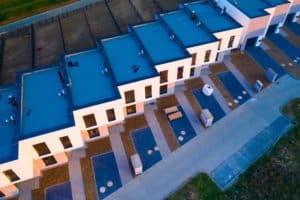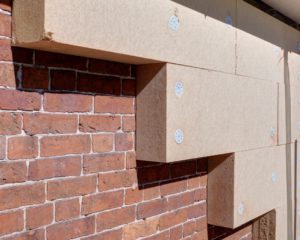What is Diathonite Thermal Plaster and how can it improve the energy performance, thermal and sound insulation of a building? Read on to find out.
Unfortunately, historic buildings are far from the most energy efficient and it can be difficult to improve their carbon and energy performance without damaging the buildings heritage values. With this in mind, energy efficiency solutions need to be well-considered and slot in seamlessly to the nature of the historic building. Developers need to seriously consider whether their methods will harm or taint the significant history of the site and whether they are sustainable as well as providing a healthy environment for visitors.
In particular, It can be a challenge to find the right insulation product when working with traditional and heritage buildings with solid stone or masonry walls. Whilst it was thought that a compromise must be made between thermal performance and aesthetic, this doesn’t have to be the case. There is a sweet place in between and it’s an incredible product called Diathonite Thermal Plaster.
Within this blog, we will discuss Diathonite Thermal Plaster in detail and how beneficial and life changing it can be for our magnificent historic buildings within the UK.
What is Diathonite Thermal Plaster?
Diathonite Thermal is one of the best performing eco-thermal plasters out there, with fantastic thermal and sound insulation properties for solid wall construction. The plaster helps to regulate moisture to control damp and humidity in solid walls of older buildings, following the contours of stonework or curved walls while helping to maintain the original charm and beauty of the buildings. Other benefits include:
- It is one of the most eco-friendly insulation plasters on the market, with less than 2% inorganic material
- It is highly vapor permeable, removing the risk of condensation
- Very good thermal insulation properties, conducting at 0.45 W/mK
- Sound absorption between 600 and 1500 Hz is greater than 70%
Diathonite Thermal Plaster is also recognised by multiple sustainability certifications such as Environmental Product Declaration (EPD) and Leadership in Energy and Environmental Design (LEED), which recognises that Diathonite Plaster helps to contribute to healthier spaces, air, better thermal comfort and energy saving, involving all phases of lifecycle.
What Diathonite Thermal Plaster products are available?
Within the Diathonite Thermal Plaster range, they have all been made to cater to individual project specifications. For example, there are products made for both internal and external plastering, finishing plasters, sound absorbent plasters and salt resistant plasters.
From Diathonite Deumix Plus and Diathonite Regularisation to Diathonite Evolution and Diathonite Thermactive, it’s essential that you pick the correct products for your project. These include:
Diathonite Thermactive: Diathonite Thermactive plaster is for internal stone or masonry walls and ceilings. It will help to insulate the building and maintain the breathability of the wall/ceiling, whilst protecting occupants from cold in winter and overheating in the summer!
Diathonite Deumix: Diathonite Deumix is made from natural Hydrated lime, NHL 5 binder, clay, rock and diatomaceous earth, making it a robust thermal insulating plaster and salt inhibitor.
Diathonite Acoustix: Diathonite Acoustix is an eco-friendly cork-based sound absorbent plaster. Used for brick, plaster, concrete, stone, masonry or wood on both external or internal walls and ceilings, it helps with noise reduction, sound absorption and thermal benefits.
Diathonite Evolution: Diathonite Evolution is a lime, cork and clay based insulated plaster, made for insulating buildings and maintaining the breathability of internal or external solid stone or masonry walls and ceilings.
Diathonite Regularisation: Diathonite Regularisation is a lime based restoration plaster and salt barrier, helping to strengthen walls and protect against severe salt penetrations and deposits.
How do you prepare Diathonite Thermal Plaster?
Prior to applying Diathonite plaster, it’s essential that the surface of the wall is in an appropriate condition. This includes:
- The surface should be thoroughly clean, well consolidated and without debris or detaching parts.
- If there is any existing plaster non painted, ensure that this is solid and completely attached to the substrate. This will ensure that the wall is fully breathable and allows the Diathonite to work to its full potential.
- Check the substrate, repair and fix damaged or non well anchored bricks, stones or blocks.
- Check for signs of water ingress or ground source damp issues. If there is evidence of this, ensure that it is remedied before applying Diathonite.
- If applied on smooth surfaces such as concrete pillars, existing plaster, wood or metal, it may be necessary to apply the adhesion primer Aquabond, to ensure optimal adhesion.
How do you apply Diathonite Thermal Plaster?
Diathonite is easily installed either by hand or, for larger surface areas over 100m2, with a plaster spraying machine. If you are applying by hand, steps include:
- Wetting the surface – This is fundamental during the summer season and if the walls are exposed to the sun!
- Apply a first coat of Diathonite Thermal Plaster with a trowel in layers of 15 – 25mm thick.
- Let it dry for 24 hours
- Over the applied coat, prepare the area creating the reference bands to obtain the required thickness.
- Apply successive layers up to the required thickness, only adding on a new layer when the below is dry, which can take up to 24-48 hours. The total thickness needed will depend on the required U value of your project, but typically 40-60mm is the most cost-effective thermal improvement.
- For thickness that exceeds 60mm, a plaster mesh should be applied at about half of the total thickness.
- Prop and smooth as for a normal civil plaster.
In contrast to traditional lime plasters, Diathonite lime-based plaster speeds up drying time significantly, drying at about 2mm per day which is twice the speed of traditional line. This means that 30mm of Diathonite thermal plaster will dry after two weeks rather than one month, offering substantial benefits in quicker project delivery.
Finishing touches for Diathonite Thermal Plaster.
The finishing touches chosen for Diathonite thermal plaster will vary depending on whether it has been applied internally or externally.
Internally:
The plaster should be finished with two coats of Diasen Argacem HP for a semi-smooth textured finish. For a very smooth finish, a Diasen Argacem Ultrafine can be applied over the top of Argacem HP. After this has dried fully, a natural breathable paint such as Auro, Decork or lime paint can be applied.
Externally:
After a Diasen Argacem HP finishing plaster has been applied, a protective finish is needed, such as a breathable paint that eliminates the risk of moisture build-up from wind, rain and moisture on external walls. The breathability will allow moisture from the structure to dry out and minimize the risk of cracking.
Can Buildpass help me choose the best thermal insulation product?
Yes! From concept to post-occupancy, we have a range of specialists available to talk to you about your projects, helping you to navigate through the complexities. Get booked in for a FREE call with a member of the team today!




















